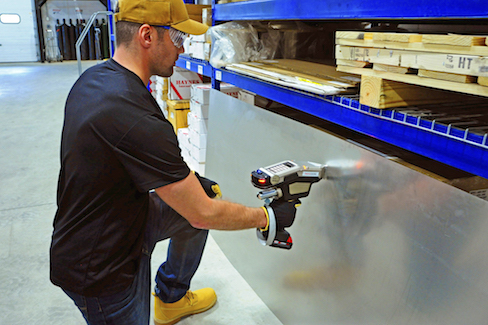Understanding Carbon Content and Equivalency in Welding
Welding mistakes on an oil-and-gas worksite can endanger welders and inspection personnel. To increase productivity and safety and reduce costs, educate them on how to assess the materials they’ll be using before work begins in the field.
Posted: September 28, 2020
Steel is one of the world’s most innovative and essential materials for fabrication, metal cutting, and construction. In the oil-and-gas industry, steel is used throughout the pipeline. It comes in a variety of compositions and has unique properties, with carbon acting as a key element.
Carbon is added to steel during the fabrication process to increase properties such as corrosion resistance, weldability, ductility, and hardness; but also builds up naturally as a result of residual elements deposited by hydrocarbons flowing through pipes. As a result, carbon content and equivalency are incredibly important for both welders and inspection personnel to understand when building and maintaining a worksite.
The Dangers of Alloy Misidentification
Reducing the risk of fires, equipment failures, and transportation-related accidents are usually top of mind when establishing protocols to enhance worksite safety in industries such as oil and gas. However, one of the biggest risks is potential exposure to harmful chemicals or environments due to corroded pipes or structural deficits.
Metals used in the oil-and-gas industry can be highly susceptible to corrosion due to their composite makeup as well as the buildup of carbon caused by residual elements deposited by the flow of hydrocarbons. Guaranteeing the integrity of worksite materials doesn’t stop at material identification for an individual component. When working with several materials, there needs to be an understanding of how those materials will work with one another.
This complicates the welding process when selecting the right materials to match the conditions under which it will be used.
For instance, the composition of alloy components needs to be consistent with the selected or specified construction materials necessary to maximize quality control and minimize the release of hazardous liquids or vapors. If the wrong material is used, there are calculable rates at which things start to corrode. Once corrosion has started, failure at the site is almost imminent. These types of risk can lead to instant failure and a potential worksite shutdown.
Carbon’s Role In Welding
When higher levels of carbon are present, the material used will typically have increased hardness, brittleness, yield point, tensile strength, and – in some field environments – increased rusting. These properties decrease weldability, plasticity, ductility, and resistance to air corrosion.
Understanding the differences in chemistry through carbon equivalency (CE) calculation enables welders to determine if the properties of two materials joined together via a filler metal component are compatible. Armed with this information, they can then determine what precautions – such as prescriptive heat treatment, use of low-hydrogen electrodes or controlling heat input – are necessary before and during welding to create a more reliable asset.
When analyzing CE, one of the most important aspects inspection personnel need to consider is the material’s susceptibility to corrosion. Materials that corrode easily and/or quickly are less ideal in a piping system than those that can withstand corrosive materials and/or extreme conditions.
When welding, CE calculations are used to predict heat-affected zones (HAZ). This can determine if the two joining materials are compatible, and if further site precautions need to be taken.
Unfortunately, a variety of highly technical factors can lead to corrosion. These include welding the wrong metals together, the composition of different metals that vary in thermal resistance (for example, copper versus stainless steel), and the existence of ferrous materials or sulfurization caused by high-temperature hydrocarbons. If welders don’t have the carbon content right they won’t know which elements they’re able to join.
Identifying Levels Of Carbon
Over the years, the industry has adopted technologies such as optical emission spectroscopy (OES) and, more recently, laser-induced breakdown spectroscopy (LIBS) to help inspection personnel better understand the carbon makeup of assets throughout worksites. Both technologies are effective, but vary in functionality. For example, OES applies electrical energy in the form of a spark generated between an electrode and a sample, while LIBS uses a high-energy pulsed laser to ablate a sample.
Today, more manufacturers are implementing technology that can quickly, easily, and accurately test materials in the field. LIBS is available in a handheld instrument that identifies the elemental composition of carbon steels in seconds. Site inspectors and workers can eliminate risks associated with welding incompatible alloys as well as the need for expensive third-party inspectors. They can also confirm or replace inaccurate or lost material test reports, allowing fabricators to profit from the previously unidentified product, and determine between like alloys (e.g., CS 1020 and 1025) in mission-critical applications.
A portable device means inspectors don’t have to carry around bulky inspection materials. The ability to quickly detect and identify low-alloy/carbon steels and L- and H-grade stainless steels enables employees to quickly understand the contents and composition of their worksite. Accuracy and repeatability in technology are essential to validate test results and ensure worksite safety.
Carbon And A Safer Worksite
Welding mistakes on an active oil-and-gas worksite can pose a series of risks to workers. Educate welders and inspection personnel on the pros and cons of specific materials being used, as well as the importance of particular elements at play such as carbon, before work begins in the field. In addition to improving worksite safety, giving them the right tools and information will lead to less downtime, higher productivity and reduced costs over time.















